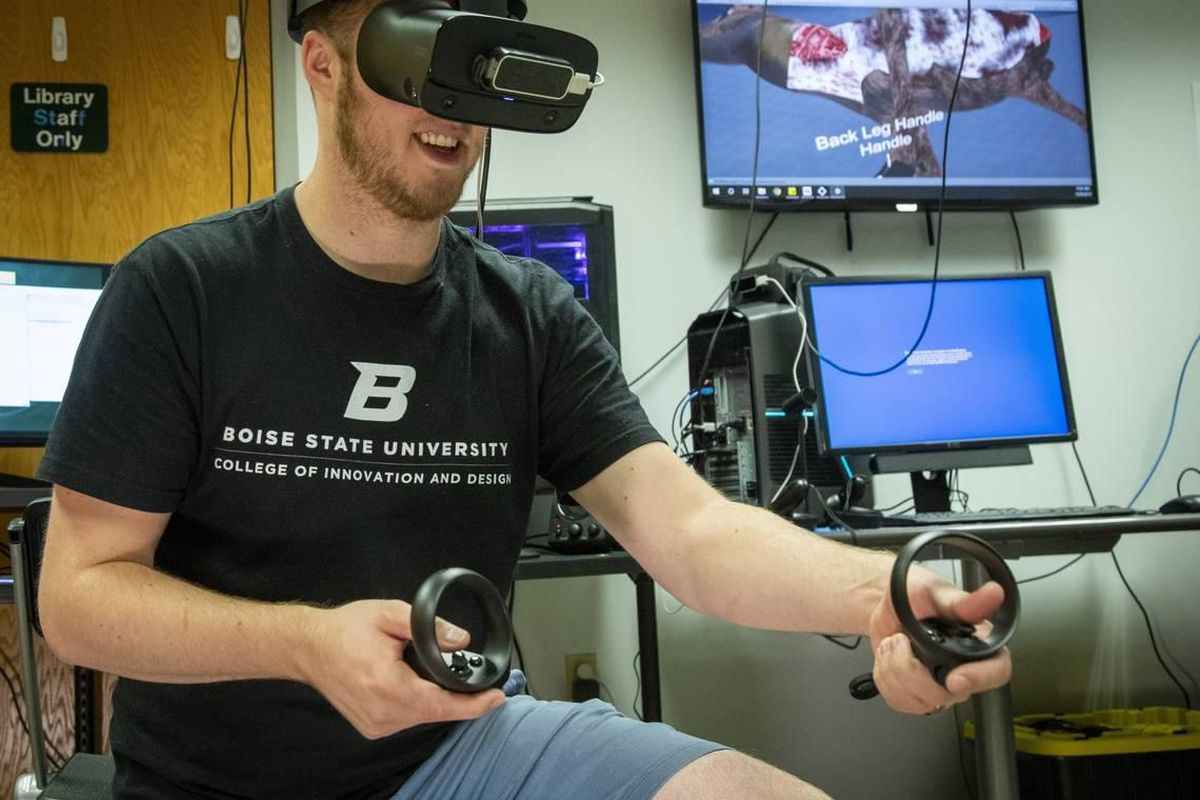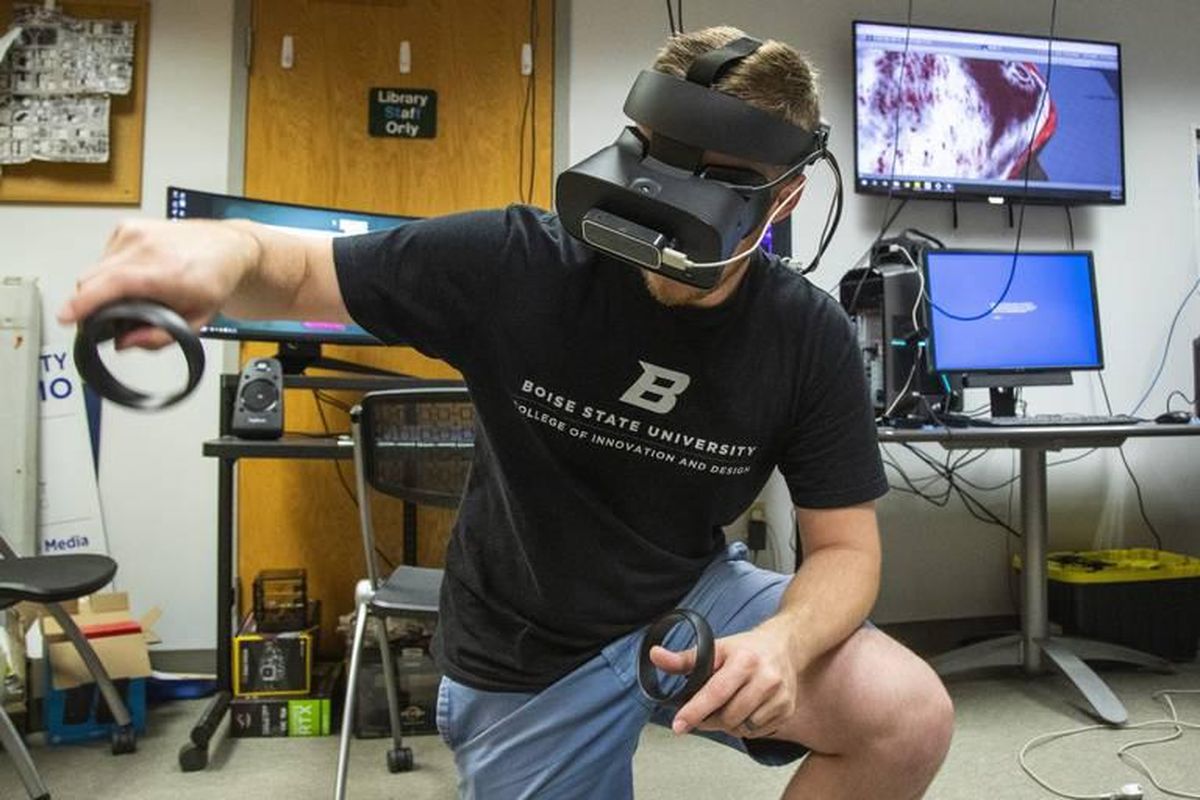Idaho Fish and Game wants new hunters. So it created a video game to help them learn
Dakota Kimble, a student in Boise State’s Gaming, Interactive Media and Mobile Department, gutlessly field dresses an elk in virtual reality. Kimble and Brannon Leman designed, programed and produced the education tutorial for Idaho Fish and Game. (Katherine Jones / COURTESY)
BOISE – Crouched down in the forest, knife in hand, Brennon Leman starts to skin the bull elk lying dead on the ground.
He draws his blade across the animal’s belly, over its legs and along its neck, peeling back the hide bit by bit. Leman removes the elk’s legs and trims off cuts of meat, laying them off to the side.
When the animal is fully butchered, Leman stands up, sets down the controllers in his hands and removes his virtual reality headset.
Though he’s never shot an elk, Leman has gone through this simulation enough times that he’s confident he could skin the animal and harvest its meat. That’s exactly what the Idaho Department of Fish and Game had in mind when it asked Leman and his fellow students at Boise State University’s Games, Interactive Media, and Mobile Technology program to design a virtual reality field dressing.
“In hunter education, sometimes we’ll show a video (of field dressing), but it doesn’t build that muscle memory,” said Ian Malepeai, director of marketing for Fish and Game.
In the past, Malepeai said, Fish and Game has used videos or diagrams or had new hunters practice “skinning” a wrapped candy bar. But those techniques don’t really prepare a fledgling hunter for the reality of field dressing, or cleaning and butchering a big game animal in the field.
So Malepeai started looking for a better way to teach those skills. He approached Anthony Ellertson, director of the GIMM program and a lifelong hunter, in 2018 to see if Boise State students were up to the task.
Ellertson was certain his students could handle the request. He assigned the project to GIMM students Leman and Dakota Kimble as a senior capstone. Leman and Kimble were paid for their work on the simulation, which started in October 2018.
Together, they created a 3D model of an elk, replicated an actual Idaho wilderness scene in which to place that elk and pioneered new VR tech to make a realistic hide that can be skinned from the rest of the animal.
“Brennon and Dakota didn’t grow up hunting,” Malepeai said, “but through this they want to take hunters education and go hunting. We can inform and inspire people to want to do it.”
How VR hunter
education works
Users start by donning a virtual reality headset and taking a controller in each hand. The controllers each feature several buttons, which function as the user’s “fingers” to allow them to grasp items. Once the headset is on, users find themselves in a replica of the Idaho wilderness.
To the left, users can see instructions that guide them through the field dressing process. The user points the controller at a button under the instructions to spawn a knife, which can be passed from hand to hand and gripped multiple ways. (It also can be dropped, but fortunately there are endless respawns.)
The elk’s body is already on the ground in front of the user, who must crouch down, move around the body, lift and pull the hide and maneuver the knife. A series of colored dots shows hunters where they’ve already cut, which area they must cut next and what cuts should come after that. The simulation walks users through the gutless method, a field dressing technique in which the hunter cleans the animal without opening the body cavity or handling the guts of the animal.
As users begin making knife cuts, the instructions to their left change, guiding them to remove the hide and cuts of meat and leave evidence of sex (as proof to Fish and Game that the hunter filled the appropriate tag). The whole process usually takes less than half an hour, and GIMM director Ellertson said users get faster and more adept as they continue to use the simulation.
“The more time you spend in this environment, the easier it gets,” Ellertson said.
To give the students an idea of how the process works, Malepeai demonstrated the gutless method on a roadkill deer. The sound effects in the game as hunters remove virtual flesh are recordings from Malepeai’s demonstration.
The simulation is precise in the way that 2D instruction (or a candy bar wrapper) never could be.
“The meat and the skinning process are accurate,” said Malepeai, who has been hunting in Idaho all his life. “This truly will help Idaho hunters.”
Kimble and Leman created the game using Unity, a game engine that serves as a software framework for multiple gaming platforms. It’s compatible with Oculus virtual reality systems, including the Rift and Quest consoles. Ellertson said the gaming headsets are steadily growing in popularity, especially among younger people.
The benefits of virtual reality
The high-tech hunting simulation is a modern solution for a modern problem. Years ago, families often passed hunting down as a tradition. That has become less and less common, leading to declining hunter numbers and a loss of knowledge about hunting for much of the population.
“The idea of recruitment, retention and reactivation (of hunters) is relatively new,” Malepeai said. “State agencies are really looking at how they can increase participation.”
Malepeai said the biggest apprehension for hunter-education participants isn’t finding, tracking or shooting an animal. It’s what to do once the animal is dead. So having the chance to repeat the process step by step could be huge.
“It’s not just a game you play,” Malepeai said. “It’s actual hands-on experience. Even though only one student at a time is doing it … everyone can learn by watching at the same time.”
VR also can save time and money. In a best-case scenario, Malepeai said, hunter-education teachers would have an actual carcass (most likely a roadkill animal) on which to demonstrate. But that requires a lot of resources to find and preserve the animals.
Instead, Fish and Game paid about $8,000 to create its virtual reality technology – a steal, according to Ellertson. The students were paid for their work.
“A project like this would be three or four times (that cost) if you did it commercially,” Ellertson said.
Fish and Game will own the intellectual rights for the game, but Malepeai plans to make it available for free through gaming website itch.io for users with their own VR equipment. That could be beneficial for people who opt to take an online hunters education course rather than an in-person course.
Malepeai also anticipates sharing the technology with fish and game departments in other states, many of which have heard about the project and are already interested.
“We wanted to create something others could use. Currently, we have about 10 states that want to incorporate it,” Malepeai said.
Fish and Game will debut the simulation during spring hunters education classes in regions 3 (Southwest) and 6 (Upper Snake River) before bringing it to the rest of the state.

